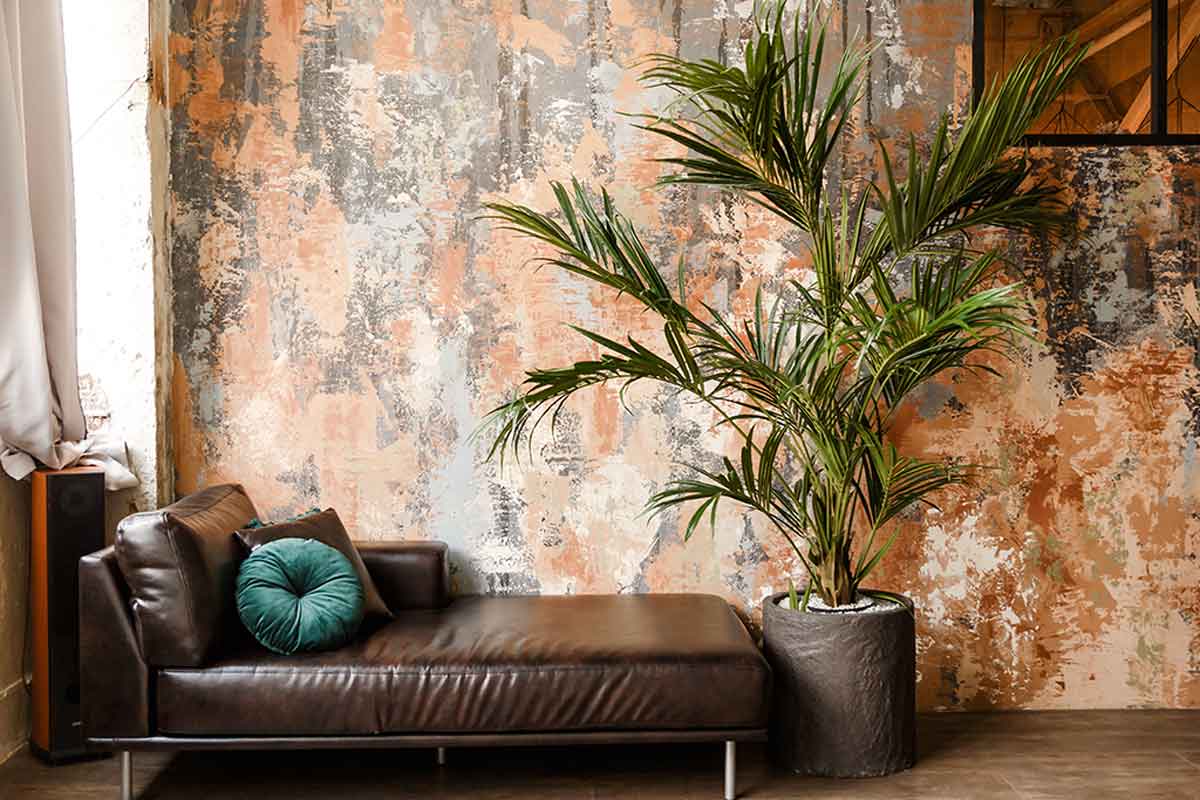Kentia: The Indoor Palm Tree That You Have to Know

The kentia is an indoor palm tree that, despite its size, has gained ground in many homes. Its large and green leaves have become an attraction. Therefore, in this article, we’ll talk about its characteristics and requirements.
Kentia characteristics
Kentia’s scientific name is Howea Forteriana and it belongs to the Arecaceae family. It’s native to the tropical Lord Howe Island, in eastern Australia, and adapts very well to indoor and outdoor spaces. Although its common name is the kentia palm, it’s actually a tree, from the trunk of which sprout between three to ten palms.
Its ability to grow in different types of soil makes it grow in many parts of the world, so you can have it in your home with specific care. In addition to its wide green leaves, it has reddish fruits, (the size of a medium egg), that attract a lot of attention, due to the contrast between the two colors.
According to articles, the kentia has been used as an ornamental plant since the 19th century. It grows more comfortably in temperate zones, between 57.2 and 77 degrees Fahrenheit. But this doesn’t mean that it doesn’t adapt well to the shade–this is an environment that this plant also enjoys and means your home is the perfect place for it to thrive.
Kentia care

The kentia palm is resistant, but it needs certain care to grow healthy and strong. As well as to always stay radiant, which is something that’s essential in any type of indoor plant. Keep reading because we’ll talk about the amount of irrigation and light you’ll need.
Irrigation
Considering its origin, kentia is a plant that requires little irrigation. Excess humidity generates the appearance of spots on the leaves, loss of color and dry leaves. Over-watering is so serious that the plant can die. Now, when there’s a lack of watering, you’ll notice that the leaves turn yellow.
Like any type of indoor plant, kentia isn’t alien to the ravages of summer. This being a time when you have to be more attentive to the conditions of the substrate to provide good irrigation.
Illumination
Contrary to irrigation, the kentia palm does need quality natural lighting to grow well. However, if your living room doesn’t have many natural light inputs, it’s not a barrier. You can still have your kentia, even if it grows a little slower.
Another requirement of the kentia is that it doesn’t tolerate sudden changes in the environment. Ideally, if you’re moving it from a bright area to a shady one, do it step by step, so that the plant has time to adapt.
Suitable temperature
The kentia palm adapts very well to different climates but enjoys more constant temperatures (around 75.2 degrees Fahrenheit). Although it could withstand moderate frosts that don’t exceed 24.8 degrees Fahrenheit.
Kentia diseases

One of the most relevant aspects that you should know about kentia are the diseases it can suffer from. The main affectations are generated by excess irrigation, which causes fungi and spots on the leaves. Therefore, it’s convenient to review the substrate to identify whether or not it needs irrigation.
In addition to these affectations, it’s necessary to be attentive because the cottony mealybug and the red spider are pests that enjoy this plant a lot. The appearance of these pests occurs more frequently in the summer, so it’s better to be alert at this time and apply a natural fungicide once a year.
Kentia: decorate your spaces naturally
The kentia palm tree is ideal to naturally decorate your spaces. It looks great on small and large floors, providing color and freshness. Now you know how to take care of it and what its basic requirements are, go ahead and open a place for it in your home.
From time to time, clean the leaves to make them shine more brightly and, if you identify that there are dry leaves that can’t be recovered, help the plant and remove them to prevent them from attracting pests.
The kentia is an indoor palm tree that, despite its size, has gained ground in many homes. Its large and green leaves have become an attraction. Therefore, in this article, we’ll talk about its characteristics and requirements.
Kentia characteristics
Kentia’s scientific name is Howea Forteriana and it belongs to the Arecaceae family. It’s native to the tropical Lord Howe Island, in eastern Australia, and adapts very well to indoor and outdoor spaces. Although its common name is the kentia palm, it’s actually a tree, from the trunk of which sprout between three to ten palms.
Its ability to grow in different types of soil makes it grow in many parts of the world, so you can have it in your home with specific care. In addition to its wide green leaves, it has reddish fruits, (the size of a medium egg), that attract a lot of attention, due to the contrast between the two colors.
According to articles, the kentia has been used as an ornamental plant since the 19th century. It grows more comfortably in temperate zones, between 57.2 and 77 degrees Fahrenheit. But this doesn’t mean that it doesn’t adapt well to the shade–this is an environment that this plant also enjoys and means your home is the perfect place for it to thrive.
Kentia care

The kentia palm is resistant, but it needs certain care to grow healthy and strong. As well as to always stay radiant, which is something that’s essential in any type of indoor plant. Keep reading because we’ll talk about the amount of irrigation and light you’ll need.
Irrigation
Considering its origin, kentia is a plant that requires little irrigation. Excess humidity generates the appearance of spots on the leaves, loss of color and dry leaves. Over-watering is so serious that the plant can die. Now, when there’s a lack of watering, you’ll notice that the leaves turn yellow.
Like any type of indoor plant, kentia isn’t alien to the ravages of summer. This being a time when you have to be more attentive to the conditions of the substrate to provide good irrigation.
Illumination
Contrary to irrigation, the kentia palm does need quality natural lighting to grow well. However, if your living room doesn’t have many natural light inputs, it’s not a barrier. You can still have your kentia, even if it grows a little slower.
Another requirement of the kentia is that it doesn’t tolerate sudden changes in the environment. Ideally, if you’re moving it from a bright area to a shady one, do it step by step, so that the plant has time to adapt.
Suitable temperature
The kentia palm adapts very well to different climates but enjoys more constant temperatures (around 75.2 degrees Fahrenheit). Although it could withstand moderate frosts that don’t exceed 24.8 degrees Fahrenheit.
Kentia diseases

One of the most relevant aspects that you should know about kentia are the diseases it can suffer from. The main affectations are generated by excess irrigation, which causes fungi and spots on the leaves. Therefore, it’s convenient to review the substrate to identify whether or not it needs irrigation.
In addition to these affectations, it’s necessary to be attentive because the cottony mealybug and the red spider are pests that enjoy this plant a lot. The appearance of these pests occurs more frequently in the summer, so it’s better to be alert at this time and apply a natural fungicide once a year.
Kentia: decorate your spaces naturally
The kentia palm tree is ideal to naturally decorate your spaces. It looks great on small and large floors, providing color and freshness. Now you know how to take care of it and what its basic requirements are, go ahead and open a place for it in your home.
From time to time, clean the leaves to make them shine more brightly and, if you identify that there are dry leaves that can’t be recovered, help the plant and remove them to prevent them from attracting pests.
All cited sources were thoroughly reviewed by our team to ensure their quality, reliability, currency, and validity. The bibliography of this article was considered reliable and of academic or scientific accuracy.
- Pauner, M. La kentia, una palmera de interior. Horticultura ornamental, flores, plantas y árboles. Núm. 150.







